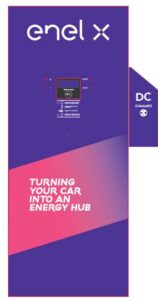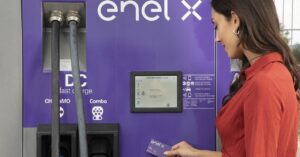ST was one of the exhibitors at the European Utility Week, and among the many demos and partners that brought our space to life, Enel X showcased its JuicePole. The Italian company offers smart infrastructure as well as smart energy solutions, and the JuicePole aims to popularize electric vehicles charging stations. Its small dimensions comparable to a parking meter, the presence of up to two chargers, and a 10-inch color screen can transform streets and areas with minimal impact on the overall aesthetic. Enel X also offers other charging solutions, such as the JuicePump, which resembles a pump in a gas station, and a vehicle-to-grid platform that flips the script by allowing electric cars’ batteries to support an electrical grid to make it stabler while charging the vehicle.
[pretty-callout align=”right”]Fun Facts
- Enel X installed more than 3,500 public charging stations across Italy. About 90% are JuicePole; the rest is JuicePump.
- Enel X shipped its first smart meter 20 years ago. It had ST components in it.
The research around range anxiety is rich and fascinating. In a paper entitled “Electric Vehicle Range Anxiety: An Obstacle for the Personal Transportation (R)evolution?”1, scholars show that alleviating range anxiety doesn’t require as many charging stations as there are gas stations, but only demands carefully and strategically placed infrastructure. Another study2 published in the journal Energy Research & Social Science goes a step further to show that range anxiety is primarily a rhetorical argument for EV skeptics instead of a genuinely detrimental factor to EV adoption. Hence, it is fundamental to shine a light on Enel X because the company is not looking to flood the market but aims to promote smarter, more efficient, and more innovative chargers. Let’s thus look at how they use ST components to accomplish that goal.
Enel X and SiC MOSFETs in AC/DC Converters

Enel X was one of our first partners to switch to Silicon Carbide MOSFETs. The previous version of their JuicePump used our IGBT series, but the company realized that they could build much better AC/DC converters by switching to our new products. Moving from IGBT to SiC increased the power efficiency by one percent, which is a tremendous improvement out of a small design change. The JuicePump uses three devices based on our 1,200 V ACEPACKTM 2 SiC MOSFETs (A2U100S12W-F), a compact module containing a subsystem. The device was developed in partnership with Enel X. On the other hand, the vehicle-to-grid solution embarks more than 20 discrete SCT50N120, which is a 1,200 V and 65 A device that can tolerate a really hot junction temperature (200 ºC) and offer a low on-resistance of only 70 mΩ at such extreme conditions.
Enel X and SPEAr MPUs as the Main Host
The JuicePump, JuicePole, and the vehicle-to-grid solutions all use ST’s SPEAr microprocessors. The former embarks a SPEAr310 while the other two rest on a SPEAr320. Engineers at Enel X first decided to use them a decade ago because they met their technical specifications. The MPUs can run a full operating system while offering SPI, Ethernet, and USB interfaces, to facilitate communications with other daughterboards. The SPEAr320 even offers two CAN buses. Additionally, the teams already had SPEAr evaluation boards, which meant they were familiar with the architecture and could start prototyping faster. The fact that Enel X uses SPEAr MPUs also testifies to its long partnership with ST and our ability to support our products for a long time. Today, companies would gravitate toward an STM32 MCU or our STM32MP1 MPU, which houses two Cortex-A7 and a Cortex-M4.
Enel X and STreamPlug ST2100 Between the Car and the Charger

Finally, another component that the JuicePump and vehicle-to-grid use is the STreamPlug ST2100, which manages the power line communication (PLC) between the electric car and the charger. The system can query the vehicle to determine the electrical characteristics of the battery and adjust the charging process. In fact, Enel X worked with ST to develop an ST2100 interface board that would connect to the SPEAr evaluation PCB through SPI. This partnership enabled Enel X to prototype a system and learn how to use STreamPlug quickly. It is also a great example of how ST and its partners come together to create tools that will hasten developments and reduce the time to market. Once Enel X completed its interface board finished, it had a tool it could use on many other devices and projects for the foreseeable future.
- D. Pevec, J. Babic, A. Carvalho, Y. Ghiassi-Farrokhfal, W. Ketter and V. Podobnik, “Electric Vehicle Range Anxiety: An Obstacle for the Personal Transportation (R)evolution?,” 2019 4th International Conference on Smart and Sustainable Technologies (SpliTech), Split, Croatia, 2019, pp. 1-8.doi: 10.23919/SpliTech.2019.8783178 ↩
- Lance Noel, Gerardo Zarazua de Rubens, Benjamin K. Sovacool, Johannes Kester, “Fear and loathing of electric vehicles: The reactionary rhetoric of range anxiety”, Energy Research & Social Science, Volume 48, 2019, Pages 96-107, ISSN 2214-6296, https://doi.org/10.1016/j.erss.2018.10.001 ↩
